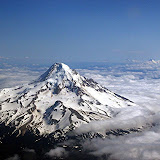Mentor - Flight & Photography: 3 of 4, Photos from a Jet Airliner window




Mentor
The Aerial photos from a jetliner are fun, and with digital photography and editing, can create amazing art and photos.
For starters, you don't have to worry about any FAA regulations. But you do need to secure a window seat and not over the wing. In front of the wing is best as you won't pick up distorted air imagery from thrust gasses exiting under-slung engine pods. Try to pick a clean window, for obvious reasons.
When shooting from an airliner window, glare is your enemy. Here are a few tips: Wear a dark shirt, as lighter colors reflect back onto the plexiglass and alter your photo. Nothing worse than a ghostly shirt button floating in the middle of your photo! Also, be aware of sunlight slanting into the plane through the window. Avoid it if you can, but if you cant, increase the angle between your camera lens and the angle of entry of the sunlight for best results. Go crazy on the shutter, and experiment with different angles.
Back on the ground, you'll be glad for all the images you shot as not all will be usable. For the ones that are, you want to minimize the effects of the airliner window. Sharpen the image as best you can, and increase brightness and contrast, playing with the balances. Reflections can sometimes be eliminated by selectively altering contrast and brightness for specific large areas of the image.
All of the photos shown here were taken from an airliner departing from or arriving into the Pacific Northwest. Whenever I could I took shots of Mt. Hood, and was rewarded by capturing the seasonal changes on the mountain over the course of a year. Looking at a glacier carved river valley from the Flight Levels gives new perspective to the awesome ancient power of flowing ice which can carve out valleys and leave a smooth sculpted curve pathway that lasts forever.
Don't be afraid to include the wing, sometimes it increases the effect, as with these unusual cloud rows of The Northwest Bitteroot Mountains.
Onward & Upward! ~ rfb









1 comment:
A correspondant on iPilot started a discussion with me on aerial photography through the jet airliner window, and what techniques I used. Here is the response I lefet on iPilot -
Years of practice, to the annoyance of cabin staff and passengers who would rather see me pull the blinds on reality and settle in for another helping of video delights delivered on tiny screens!
Digital photography really accelerated my learning curve. With slides, I'd guess, take the shot, note the results a week later, and make correction as as I could next time I flew. With digital, you can edit and shoot again in seconds.
I learned it's best if the sun is coming from the other side of the cabin or at an angle that reduces, or evenly distributes glare. Evenly distributed glare can be dealt with in a photo editing program; as long as the visual detail is there, color shift and contrast can be corrected.
I try to shoot as near to perpendicular as I can out the window, and to minimize reflection, I put my left knuckle out as I stabilize the camera, (Holding with both hands, clicking with the right)and touch the window to guarantee I am close, then pull off the window just a tad (1/4 inch range) so that I don't pick up any mechanical vibration, and shoot away.
It is very useful to have the small LCD screen; I know, it can be dim, but that doesn't matter; for shooting the shot I use it to frame the overala image which can be seen even in dim screen presenations.
I also keep it as wide angle as I can, knowing that iamge disturbances of any sort are magnified and enhanced with any use of telephoto. I also never use the digital zoom componant, combined with the window quality , it always drastically reduces image appearance.
The rest is fate - get a window seat, hope for something interesting, hope that there aren't strange smears on the window or age-induced hazing and cracking, and try for in front of the wing rather than behind the wing, where the exhaust can distort the image.
If you get some good shots, upload them on Google's Picasa and let us take a look! (If you don't have Picasa, consider downloading it through the link at the bottom of my why2fly.blogspot.com blog). Yes, I collect a little referral money but it goes to an excellent cause, helping keep aviation strong by funding gas money for a fellow pilot!
I look forward to hearing about other's successes and experiemnts with aerial photography, and seeing any images others have taken.
~ rfb
Post a Comment